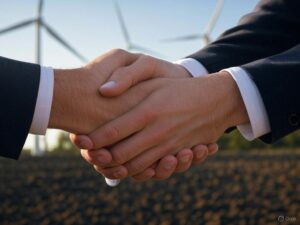Renewable Energy Generation Set to increase by 84% in the Next Five Years Driven by AI and Global Electrification-Says BloombergNEF’s New Energy Outlook 2025

According to BloombergNEF’s (BNEF) newly released New Energy Outlook 2025, global renewable power generation is poised for a dramatic surge, expected to grow by 84% over the next five years. This rapid expansion marks a significant acceleration compared to previous periods and highlights the growing influence of new energy-intensive industries, particularly data centers driven by advancements in artificial intelligence (AI).
The report outlines that the world’s transition to greener energy sources is no longer just about climate commitments or government mandates. Instead, economic and technological shifts are driving a profound restructuring of energy demand and supply. The proliferation of AI technologies, cloud computing, and the broader digital economy is creating an unprecedented need for electricity, much of which companies and governments aim to meet through sustainable energy solutions.
BNEF’s Economic Transition Scenario suggests that by scaling up renewable power generation and improving energy efficiency, the world could reach a critical turning point: a sustained decline in greenhouse gas emissions. Under this scenario, global energy-related emissions are projected to peak within the next few years and then fall steadily, dropping by approximately 22% by mid-century.
Surging Electricity Demand from Emerging Sectors
One of the most striking elements of BNEF’s analysis is the role of new technologies in reshaping energy consumption patterns. The report highlights the explosive growth of AI-powered data centers, which are becoming major electricity consumers. As AI applications—from large language models to autonomous systems—become integral to business and daily life, the demand for data processing and storage has surged. Data centers, known for their massive power requirements, are therefore at the heart of a new wave of energy demand.
Other sectors contributing to this growing demand include the continued electrification of transportation, the expansion of manufacturing industries, and rising living standards in developing economies. Countries across Asia, the Middle East, and Africa are seeing rapid urbanization and industrialization, further increasing electricity consumption.
The Role of Renewable Energy in Meeting New Demand
To meet these rising demands sustainably, renewable energy sources such as solar, wind, and hydropower are expected to dominate new electricity generation. BNEF’s projections show that renewables will account for nearly all of the net growth in electricity production over the next half-decade. This means that as global power demand expands, it will be renewables—not fossil fuels—that supply the additional energy.
Technological improvements have played a crucial role in making renewables more competitive. Costs for solar photovoltaic (PV) panels and wind turbines have dropped significantly over the past decade, making these sources more accessible and profitable. Additionally, advancements in energy storage technologies, such as batteries, are helping to address the intermittency challenges that previously limited renewable energy’s potential.
Investment Trends and Policy Support
The transition to renewables is also underpinned by major shifts in investment flows. BNEF notes that global investment in renewable energy projects, energy storage, and supportive infrastructure like smart grids continues to grow at a robust pace. Financial markets increasingly favor sustainable investments, driven by both government policies and growing pressure from shareholders and the public for corporate climate responsibility.
Governments worldwide are stepping up their support for renewable energy through subsidies, tax incentives, and regulations mandating cleaner energy sources. Major economies, including the United States, the European Union, and China, have launched comprehensive plans to accelerate the deployment of renewables. Meanwhile, emerging markets are also prioritizing renewable energy to improve energy access and economic resilience.
Global Emissions Outlook and Structural Decline
Perhaps the most significant outcome of this rapid renewable energy expansion, according to BNEF, is the potential for a structural decline in global carbon emissions. For decades, global emissions have risen in parallel with economic growth. However, BNEF’s Economic Transition Scenario envisions a decoupling of economic prosperity from carbon output.
Under the scenario, the world’s energy-related emissions peak around the middle of the current decade and then enter a sustained period of decline. By 2050, emissions could fall by 22% compared to today’s levels. Achieving this would represent a major step toward limiting global temperature rise and meeting the goals of the Paris Agreement.
Nevertheless, the report stresses that additional measures beyond renewables are necessary to stay on track with more ambitious climate targets, such as achieving net-zero emissions by 2050. These measures could include advancements in carbon capture technologies, widespread adoption of green hydrogen, and continued improvements in energy efficiency across sectors.
Challenges and Risks
Despite the optimistic projections, BNEF acknowledges several risks that could slow the renewable energy boom. Supply chain disruptions, regulatory hurdles, and land use conflicts are potential challenges that could delay project development. Moreover, integrating large amounts of variable renewable energy into electricity grids will require significant upgrades to existing infrastructure.
There are also geopolitical risks to consider. International cooperation is critical for scaling clean technologies, but tensions between major powers could complicate global climate efforts. Financing the energy transition in low- and middle-income countries remains another significant hurdle, as these regions often face higher capital costs and greater political risk.
A New Energy Era
The upcoming surge in renewable energy generation marks the beginning of a new era in the global energy system. The convergence of technological innovation, economic incentives, and societal demands for sustainability is reshaping how the world produces and consumes power.
BNEF’s outlook paints a picture of a world in transition: one where renewable energy becomes the dominant force in electricity generation, supporting a digital, electrified, and increasingly sustainable global economy. While challenges remain, the foundations for a greener future are being laid today—with the next five years set to be a defining period for the energy transition.






